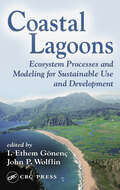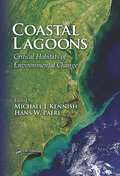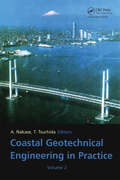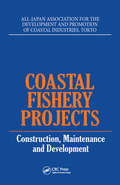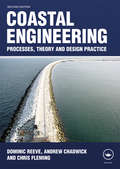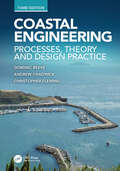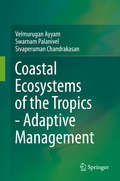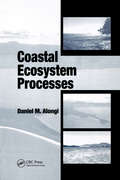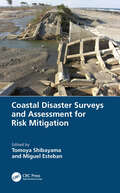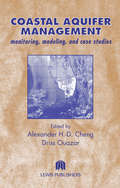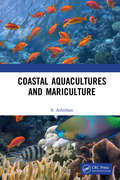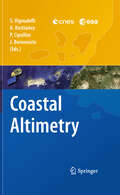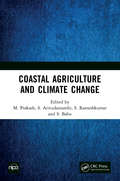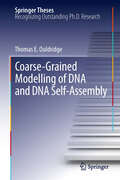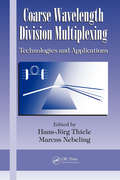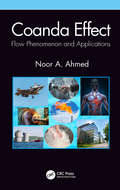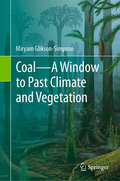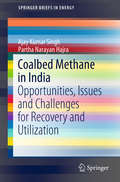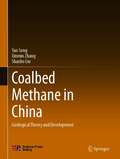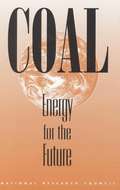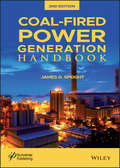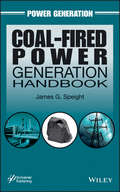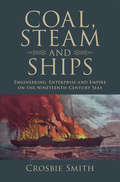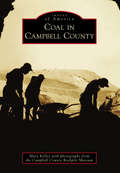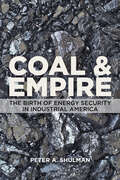- Table View
- List View
Coastal Lagoons: Ecosystem Processes and Modeling for Sustainable Use and Development
by John P. Wolflin I. Ethem GönençCoastal Lagoons: Ecosystem Processes and Modeling for Sustainable Use and Development describes the concepts, models, and data needed to design and implement management programs for long-term sustainability of coastal lagoons. Based on a project conducted under the auspices of NATO-CCMS, the book provides information and methodologies essential for
Coastal Lagoons: Critical Habitats of Environmental Change (ISSN)
by Michael J. Kennish Hans W. PaerlWritten by an outstanding group of contributors, this book examines the function and structure of coastal lagoonal ecosystems and the natural and anthropogenic drivers of change that affect them, most notably nutrient over-enrichment from coastal watersheds and airsheds. The contributors target the susceptibility of coastal lagoons to eutrophication, the indicators of eutrophic conditions, the influences of natural factors such as major storms and other climate effects, and the resulting biotic and ecosystem impairments that have developed. The book compares biogeochemical and ecological response to nutrient enrichment and other pollutants in lagoonal estuaries to those in other estuarine types.
Coastal Geotechnical Engineering in Practice, Volume 2: Proceedings of the International Symposium IS-Yokohama 2000, Yokohama, Japan, 20-22 September 2000
by Takashi Tsuchida Akio NakaseThe International Symposium on "Coastal Geotechnical Engineering in Practice (IS-Yokohama 2000)" was held from 20 to 22 September 2000 in Yokohama, Japan and sponsored both by TC-30 of ISSMGE on "Coastal Geotechnical Engineering" and by the Japanese Geotechnical Society (JGS). This symposium attracted 310 participants from many countries and IS-Yokohama 2000 is remembered as a successful event for gathering valuable information and experiences from various researchers and case studies on soft ground engineering technology in coastal areas. During the symposium participants heard invited leading experts present lectures and reports and had a chance to meet with representatives of various research fields of interest. As a fulfilment of the promis made during the symposium, a second volume was produced after the conference with contributed paper of those presentations in keynote addresses, special lectures, project reports and special discussion sessions, with the hope that this will be a valuable reference for engineers, academics, consultants and those who are interested in Coastal Geotechnical Engineering.
Coastal Fishery Projects
by V. PanditA manual on the development and reconstruction of coastal fishing areas. Coverage ranges from design conditions, through use of tidal currents for sea water flow, to improvement of water quality and breeding facilities.
Coastal Engineering: Processes, Theory and Design Practice
by Andrew Chadwick Dominic Reeve Christopher FlemingHistorically, much harm has been done by well-meaning coastal engineering attempts, which seemed like good ideas on paper but which failed to allow for practical issues. For this reason, it is vital that theories and models are well grounded in practice. This second edition brings the models and examples of practice up to date. It has expanded coverage of tsunamis and generating energy from waves to focus both on the great dangers and the great opportunities that the ocean presents to the coastal zone. With an emphasis on practice and detailed modelling, this is a thorough introduction to all aspects of coastal processes, morphology, and design of coastal defences. It describes numerous case studies to illustrate the successful application of mathematical modelling to real-world practice. A must-have book for engineering students looking to specialize in coastal engineering and management.
Coastal Engineering: Processes, Theory and Design Practice
by Andrew Chadwick Dominic Reeve Christopher FlemingEffective coastal engineering is expensive, but it is not as costly as neglect or ineffective intervention. Good practice needs to be based on sound principles, but theoretical work and modelling also need to be well grounded in practice, which is continuously evolving. Conceptual and detailed design has been advanced by new industry publications since the publication of the second edition. This third edition provides a number of updates: the sections on wave overtopping have been updated to reflect changes brought in with the recently issued EurOtop II manual; a detailed worked example is given of the calculation of extreme wave conditions for design; additional examples have been included on the reliability of structures and probabilistic design; the method for tidal analysis and calculation of amplitudes and phases of harmonic constituents from water level time series has been introduced in a new appendix together with a worked example of harmonic analysis; and a real-life example is included of a design adapting to climate change. This book is especially useful as an information source for undergraduates and engineering MSc students specializing in coastal engineering and management. Readers require a good grounding in basic fluid mechanics or engineering hydraulics, and some familiarity with elementary statistical concepts.
Coastal Ecosystems of the Tropics - Adaptive Management
by Velmurugan Ayyam Swarnam Palanivel Sivaperuman ChandrakasanThe coastal areas of the tropics are rich in biodiversity, natural resources and place of intensive developmental activities as it provides livelihood to millions of people. At the same time evidences suggest that several unique coastal ecosystems viz., mangroves, wetlands, salt marshes, corals, estuaries, sand dunes and agro-ecosystem are vulnerable to natural disasters and events associated with global climate change. In recent times degradation of land, water and genetic erosion besides threat to native flora and fauna have been increasing due to unsustainable developmental activities. Therefore, a paradigm shift in deriving livelihood through conventional methods, developmental strategies, conservation practices are required for balanced and sustainable growth of the coastal areas. This publication strives to cover the status of different natural resources of the coastal region, various aspects of degradation process, production need and restorative methods besides new technological options and its socio-economic implications with case examples. Special focus is given to bring out the scope and potential of mangrove based farming, integrated and organic farming and its value addition besides the role of coastal vegetations as bioshield in protecting these regions from sea erosion, cyclones and tsunami. As the tropical coastal areas are vulnerable to climate change events, this book also covers the recent weather pattern, impacts of climate change and climate resilient technologies besides intuitional linkages and policy framework aimed at balancing development and environmental concerns.
Coastal Ecosystem Processes
by Daniel M. AlongiCoastal Ecosystem Processes, written by the renowned marine scientist Daniel Alongi, describes how pelagic and benthic food webs, from beaches and tidal flats to the continental edge, process energy and matter. This volume focuses on recent advances and new developments on how food webs are closely intertwined with the geology, chemistry, and physics of coastal seas. Dr. Alongi presents a process-functional approach as a way of understanding how the energetics of coastal ecosystems rely not only on exchanges within and between food chains, but how such functions are influenced by terrigenous and atmospheric processes. There is a need for documentation and an awareness of just how necessary, yet delicate, is the interplay of biological and physical forces between coastal ocean, land, and the atmosphere. Marine scientists today need to make informed management decisions about sustainable development and conservation of these fragile ecosystems. Coastal Ecosystem Processes provides present and future marine scientists the latest coastal ecosystem information to make the right decisions concerning the ecology of our oceans.
Coastal Disaster Surveys and Assessment for Risk Mitigation
by Miguel Esteban Tomoya ShibayamaThis collection covers essential concepts in the management of coastal disasters, outlining several field surveys of such events that have taken place in the 21st century, including the Indian Ocean Tsunami, the Tohoku Earthquake and Tsunami, and the storm surges generated by Hurricane Katrina, Cyclone Nargis, and Typhoon Haiyan. Measurements of flood heights, distributions of structural destruction, and the testimonies of residents are reported, with the results being analysed and compared with past events and numerical simulations to clarify and reconstruct the reality of these disasters. The book covers the state-of-the-art understanding of disaster mechanisms and the most advanced tools for the simulation of future events: • Uniquely explains how to use disaster surveys along with simulations to mitigate risk • Combines pure scientific studies with practical research and proposes procedures for effective coastal disaster mitigation Coastal Disaster Surveys and Assessment for Risk Mitigation is ideal for students in the field of disaster risk management, as well as engineers who deal with issues related to tsunamis, storm surges, high wave attack and coastal erosion.
Coastal Aquifer Management-Monitoring, Modeling, and Case Studies
by Alexander H.-D. Cheng Driss OuazarApproximately 70% of the world's population lives in coastal areas, and the majority of these people depend on coastal aquifers for freshwater. The fragility of these aquifers and their sensitivity to human activity demand informed, competent management to guarantee their survival. Significant knowledge and new technologies related to the subject h
Coastal Aquaculture and Mariculture
by S. AthithanThis book is an effort to consolidate and comprehensively present the coastal aquaculture & mariculture and divided into 39 chapters covering introduction, mariculture scenario, finfish farming, shellfish farming, molluscan farming, seaweed farming, recirculatory aquaculture systems, conservation aspects in mariculture etc. This is an attempt to provide comprehensive information on all areas of coastal aquaculture and mariculture to the students for their academic carrier. Nonetheless, the material presented has been thoughtfully selected and updated to make it of maximum use to the readers.Note: T& F does not sell or distribute the Hardback in India, Pakistan, Nepal, Bhutan, Bangladesh and Sri Lanka.
Coastal Altimetry
by Andrey G. Kostianoy Jérôme Benveniste Paolo Cipollini Stefano VignudelliThe book describes experience in application of coastal altimetry to different parts of the World Ocean. It presents the principal problems related to the altimetry derived products in coastal regions of the ocean and ways of their improvement. This publication is based on numerous satellite and observational data collected and analyzed by the authors of the various chapters in the framework of a set of international projects, performed in UK, France, Italy, Denmark, Russia, USA, Mexico and India. The book will contribute both to the ongoing International Altimeter Service effort and to the building of a sustained coastal observing system in the perspective of GMES (Global Monitoring for Environment and Security) and GEOSS (Global Earth Observation System of Systems) initiatives. This book is aimed at specialists concerned with research in the various fields of satellite altimetry, remote sensing, and coastal physical oceanography. The book will be also interesting for lecturers, students and post-graduate students.
Coastal Agriculture and Climate Change
by M. PrakashChanging climate in micro and macro level attribute to influence and bring changes in productivity and production trend of every industry including agriculture and its ecosystem. The influence of climate change and its environmental impact on coastal ecosystem greatly influence the life and livelihood of agrarian communities and people involved in allied industries. The book has been authored with objectives of providing understanding on the environmental problems, features of coastal ecosystem, advanced strategies for environmental protection, mitigation strategies for environmental problems in coastal areas and augmenting agriculture income from coastal areas.Note: T&F does not sell or distribute the hardback in India, Pakistan, Nepal, Bhutan, Bangladesh and Sri Lanka. This title is co-published with NIPA.
Coarse-Grained Modelling of DNA and DNA Self-Assembly (Springer Theses)
by Thomas E. OuldridgeThis thesis presents a novel coarse-grained model of DNA, in which bases are represented as rigid nucleotides. The model is shown to quantitatively reproduce many phenomena, including elastic properties of the double-stranded state, hairpin formation in single strands and hybridization of pairs of strands to form duplexes, the first time such a wide range of properties has been captured by a coarse-grained model. The scope and potential of the model is demonstrated by simulating DNA tweezers, an iconic nanodevice, and a two-footed DNA walker -- the first time that coarse-grained modelling has been applied to dynamic DNA nanotechnology.
Coarse Wavelength Division Multiplexing: Technologies and Applications (Optical Science and Engineering)
by Hans-Jörg Thiele Marcus NebelingExplaining what CWDM is, how it is achieved, and why it should be deployed, Coarse Wavelength Division Multiplexing: Technologies and Applications merges coverage of isolated aspects of Coarse Wavelength Division Multiplexing (CWDM) traditionally found as device-related or specific system topics. Emphasizing cost savings and performance enhancement, the book integrates information on component issues, system architectures, concepts for extensions and upgrades, as well as practical applications into a comprehensive, single-volume resource. Beginning with a summary of the ITU-T standards defining CWDM, the book addresses the three essential component classes, optical fibers, transceivers, and WDM filters, which combine to form the basis for the CWDM transmission link. The following chapters include coverage of different architectures such as hubbed rings and meshed networks, and upgrade paths to overcome limitations of current CWDM systems. The book outlines the feasibility of optically amplified CWDM systems, investigates the challenges present with high-speed CWDM and bidirectional transmission, and finally elucidates the importance of CWDM for a wide range of applications. Each chapter provides sufficient information to be used independently and contains references to relevant papers and articles for further study. The last sections of the book focus on applications and case studies where CWDM plays an ever-increasing role. They include extensive studies on networking, reach extension by amplification, and the latest concepts of transmission capacity upgrades using increased bit-rates or new channel plans. Filled with practical information, the book provides a clear understanding of recent developments in the dynamic field of CWDM.
Coanda Effect: Flow Phenomenon and Applications
by Noor A AhmedCoanda effect is a complex fluid flow phenomenon enabling the production of vertical take-off/landing aircraft. Other applications range from helicopters to road vehicles, from flow mixing to combustion, from noise reduction to pollution control, from power generation to robot operation, and so forth. Book starts with description of the effect, its history and general formulation of governing equations/simplifications used in different applications. Further, it gives an account of this effect’s lift boosting potential on a wing and in non-flying vehicles including industrial applications. Finally, occurrence of the same in human body and associated adverse medical conditions are explained.
Coal—A Window to Past Climate and Vegetation
by Miryam Glikson-SimpsonThis book focuses on the Permian time slice in the geological history of Gondwana, which includes Australia, India, South Africa, Antarctica and South America. Coal is an organic rock, the product of compressed and ‘cooked’ plants. The exact formation of coal via physicochemical reactions, burial and subsidence is the subject of numerous books. The vast thick coal deposits characterising Gondwana formed from special kind of trees termed the Glossopteris Flora. These trees shed their leaves in winter and with the rest of their remains decayed and through subsidence and burial formed the coal. Pollen preserved from these plant communities has been concentrated and isolated and is the focus of this book. The first plant communities as can be seen from the pollen graphs in this book were impoverished in species. The Permian era started with a very cold climate and as the climate warmed more and more diverse vegetation took hold. The emergence of different forms of pollen at certain times in the Permian is used as an indicator of climatic change. Furthermore, the predominance of algal spores in some samples and lack of representation by pollen of Glossopteris point to significant changes in the climate which led to the disappearance of their pollen and the accumulation of spores representing algal communities. These climate induced changes are noticed in their completed transformation after a long time span; small changes are evident during a lifetime of Earth’s inhabitants. Today, in our lifetime, we can see and witness the drying of many lakes across the Earth and their total disappearance from maps of only 50 years ago is a testimony to a climatic change taking place. The time of a ‘complete’ change in the Permian is possible to calculate. However, to determine the duration and maximum change in the climate of the earth today is impossible due to the apparent acceleration of the process by industrial activities of our species. Chapter 4 in the book deals with the special characteristics of the Permian coals of Gondwana and the special plant community which made them. The composition of these coals on a microscopic level shows them to be rich in hydrocarbons, more than other coals. The Permian coals of India and Australia generate ‘heavy’ oil which is retained within the coal matrix as bitumen and is a potential source of methane. This chapter demonstrates through a pilot study the potential for explosion in the Permian Gondwana coals through their propensity to spontaneous combustion and methane generation.
Coalbed Methane in India: Opportunities, Issues and Challenges for Recovery and Utilization (SpringerBriefs in Energy)
by Ajay Kumar Singh Partha Narayan HajraThis book offers a first-of-its-kind, standalone review of coalbed methane (CBM) in India, covering all the major technical and policy aspects. As an authoritative text on CBM in India, it addresses the essential geological, engineering and policy issues. The Coalbed Methane industry is a rapidly developing sector in Indian energy supply. The book presents the characteristics of coal beds in India's Damodar and Son river valleys, which influence the commercial viability of CBM in the regions, as well as a study of the gas contents of the country's major coalfields. The book begins with a brief review of methane emissions from Indian coal mines and the current coalbed methane situation in the country. Its unique features include a coalfield-by-coalfield technical assessment of CBM throughout India. Policy matters are addressed, including the National Exploration Licencing Policy (NELP) of the Indian Government Ministry of Petroleum and Natural Gas, which is vital to an overall understanding of CBM development in the country. The scope and depth of its book's coverage will benefit students, practising engineers, researchers and policy-makers.
Coalbed Methane in China: Geological Theory and Development
by Yan Song Xinmin Zhang Shaobo LiuThe coalbed methane (CBM) reserve in China ranks third in the world with a total resource of 36.8×1012 m3. Exploitation of CBM has an important practical significance to ensure the long-term rapid development of China natural gas industry. Therefore, in 2002, the Ministry of Science and Technology of China set up a national 973 program to study CBM system and resolve problems of CBM exploration and exploitation in China. All the main research results and new insights from the program are presented in this book. The book is divided into 11 chapters. The first chapter mainly introduces the present situation of CBM exploration and development in China and abroad. Chapters 2 through 9 illustrate the geological theory and prospect evaluation methods. Then chapters 10 and 11 discuss CBM recovery mechanisms and technology. The book systematically describes the origin, storage, accumulation and emission of CBM in China, and also proposes new methods and technologies on resource evaluation, prospect prediction, seismic interpretation and enhanced recovery. The book will appeal to geologists, lecturers and students who are involved in the CBM industry and connected with coal and conventional hydrocarbon resources research.
Coal: Energy for the Future
by Committee on the Strategic Assessment of the U.S. Department of Energy's Coal ProgramThe U.S. Department of Energy (DOE) was given a mandate in the 1992 Energy Policy Act (EPACT) to pursue strategies in coal technology that promote a more competitive economy, a cleaner environment, and increased energy security.Coal evaluates DOE's performance and recommends priorities in updating its coal program and responding to EPACT.This volume provides a picture of likely future coal use and associated technology requirements through the year 2040. Based on near-, mid-, and long-term scenarios, the committee presents a framework for DOE to use in identifying R&D strategies and in making detailed assessments of specific programs.Coal offers an overview of coal-related programs and recent budget trends and explores principal issues in future U.S. and foreign coal use.The volume evaluates DOE Fossil Energy R&D programs in such key areas as electric power generation and conversion of coal to clean fuels.Coal will be important to energy policymakers, executives in the power industry and related trade associations, environmental organizations, and researchers.
Coal-Fired Power Generation Handbook (Power Generation)
by James G. SpeightCoal accounts for approximately one quarter of world energy consumption and of the coal produced worldwide approximately 65% is shipped to electricity producers and 33% to industrial consumers, with most of the remainder going to consumers in the residential and commercial sectors. The total share of total world energy consumption by coal is expected to increase to almost 30% in 2035. This book describes the challenges and steps by which electricity is produced form coal and deals with the challenges for removing the environmental objections to the use of coal in future power plants. New technologies are described that could virtually eliminate the sulfur, nitrogen, and mercury pollutants that are released when coal is burned for electricity generation. In addition, technologies for the capture greenhouse gases emitted from coal-fired power plants are described and the means of preventing such emissions from contributing to global warming concerns. Written by one of the world’s leading energy experts, this volume is a must-have for any engineer, scientist, or student working in this field, providing a valuable reference and guide in a quickly changing field.
Coal-Fired Power Generation Handbook
by James G. SpeightThe most complete and up-to-date handbook on power generation from coal, this book covers all of today's new, cleaner methods for creating electricity from coal, the environmental challenges and concerns involved in its production, and developing technologies. It describes new technologies that could virtually eliminate the sulfur, nitrogen, and mercury pollutants released when coal is burned for electricity generation. In addition, the text details technologies for greenhouse gases capture from coal-fired power plants, as well as for preventing such emissions from contributing to global warming.
Coal, Steam and Ships: Engineering, Enterprise and Empire on the Nineteenth-Century Seas (Science in History)
by Crosbie SmithCrosbie Smith explores the trials and tribulations of first-generation Victorian mail steamship lines, their passengers, proprietors and the public. Eyewitness accounts show in rich detail how these enterprises engineered their ships, constructed empire-wide systems of steam navigation and won or lost public confidence in the process. Controlling recalcitrant elements within and around steamship systems, however, presented constant challenges to company managers as they attempted to build trust and confidence. Managers thus wrestled to control shipbuilding and marine engine-making, coal consumption, quality and supply, shipboard discipline, religious readings, relations with the Admiralty and government, anxious proprietors, and the media - especially following a disaster or accident. Emphasizing interconnections between maritime history, the history of engineering and Victorian culture, Smith's innovative history of early ocean steamships reveals the fraught uncertainties of Victorian life on the seas.
Coal in Campbell County (Images of America)
by Mary Kelley Campbell County Rockpile MuseumIn his Annual Report of the Territorial Geologist to the Governor of Wyoming 1890, Louis D. Ricketts wrote, "The coal of this district has little other use than that of supplying a local market." Years later, nothing could be further from the truth. The United States uses approximately one billion tons of coal a year, with about 390 million tons coming from Campbell County, Wyoming. Since large-scale commercial coal production began in Campbell County in the mid-1970s, most coal companies have changed names, owners, and boundaries several times. To let those changes go unrecorded would be to lose the very beginning of coal in Campbell County.
Coal and Empire: The Birth of Energy Security in Industrial America
by Peter A. ShulmanThe fascinating history of how coal-based energy became entangled with American security.Since the early twentieth century, Americans have associated oil with national security. From World War I to American involvement in the Middle East, this connection has seemed a self-evident truth. But, as Peter A. Shulman argues, Americans had to learn to think about the geopolitics of energy in terms of security, and they did so beginning in the nineteenth century: the age of coal. Coal and Empire insightfully weaves together pivotal moments in the history of science and technology by linking coal and steam to the realms of foreign relations, navy logistics, and American politics. Long before oil, coal allowed Americans to rethink the place of the United States in the world.Shulman explores how the development of coal-fired oceangoing steam power in the 1840s created new questions, opportunities, and problems for U.S. foreign relations and naval strategy. The search for coal, for example, helped take Commodore Matthew Perry to Japan in the 1850s. It facilitated Abraham Lincoln's pursuit of black colonization in 1860s Panama. After the Civil War, it led Americans to debate whether a need for coaling stations required the construction of a global empire. Until 1898, however, Americans preferred to answer the questions posed by coal with new technologies rather than new territories. Afterward, the establishment of America's string of island outposts created an entirely different demand for coal to secure the country's new colonial borders, a process that paved the way for how Americans incorporated oil into their strategic thought. By exploring how the security dimensions of energy were not intrinsically linked to a particular source of power but rather to political choices about America's role in the world, Shulman ultimately suggests that contemporary global struggles over energy will never disappear, even if oil is someday displaced by alternative sources of power.
